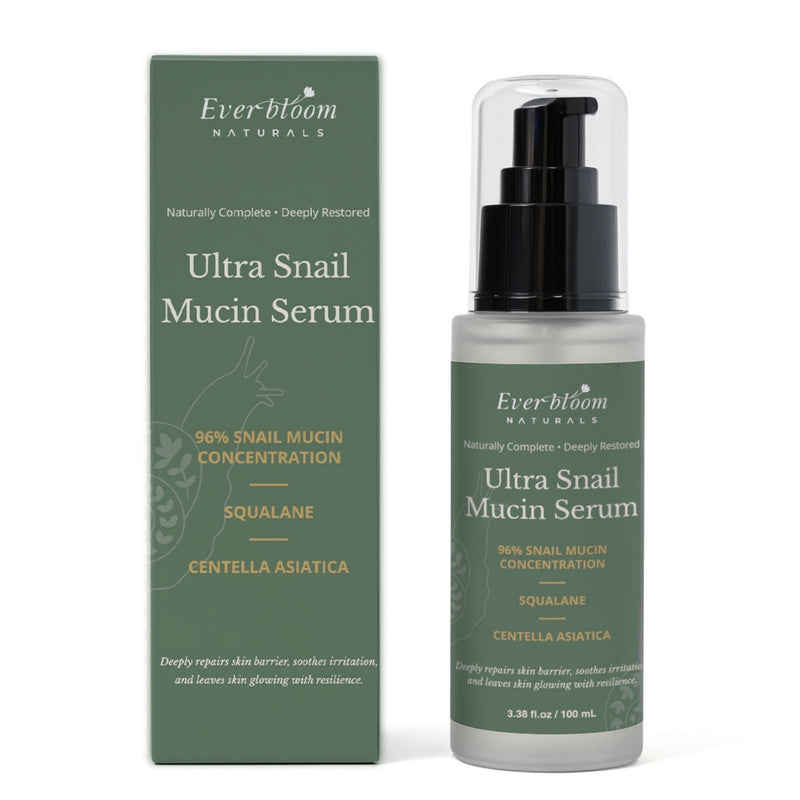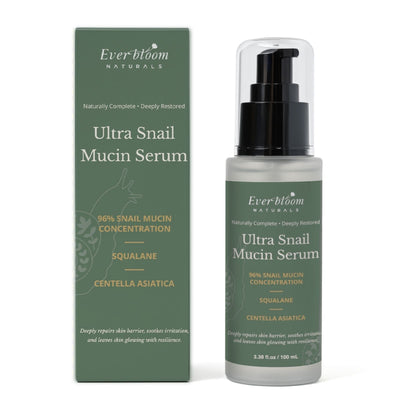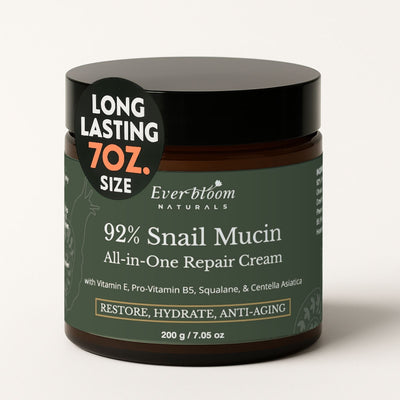The quest for healthy, radiant skin often leads us down paths of discovering potent ingredients, each promising transformative results. Among the most talked-about in recent years are snail mucin and retinol – two powerhouse ingredients that, while distinct in their mechanisms, can work wonders for your complexion. Retinol, a derivative of Vitamin A, is celebrated for its ability to accelerate cell turnover, effectively targeting concerns like fine lines, acne, and uneven texture. Snail mucin, on the other hand, is revered for its soothing, hydrating, and skin barrier-repairing properties. The natural question that arises for many skincare enthusiasts is: can you use snail mucin and retinol together to harness their combined benefits?
This comprehensive guide will delve into the individual strengths of both ingredients, explore how they can work synergistically, and provide practical advice on how to layer them safely to minimize irritation and maximize their benefits for smoother, healthier-looking skin. Whether you're a beginner or looking to optimize your existing routine, understanding the dynamics of retinol and snail mucin is key to achieving your skin goals.
Understanding Retinol: The Skin's Renewal Accelerator
Retinol is a highly effective form of Vitamin A that has revolutionized anti-aging and acne treatment in skincare. It's an ingredient that dermatologists frequently recommend due to its proven efficacy in promoting skin renewal and addressing a wide array of concerns [7].
What is Retinol?
Retinol belongs to a family of compounds called retinoids, which are derivatives of Vitamin A. When applied topically, retinol is converted by the skin into retinoic acid, the active form that interacts with skin cells. This conversion process makes retinol a gentler, over-the-counter alternative to prescription-strength retinoids, while still delivering significant benefits [3], [6].
How Retinol Works
Retinol primarily works by influencing cellular function at a deep level. Its main mechanism is accelerating skin cell turnover, meaning it encourages old, dead skin cells to shed more rapidly, making way for new, healthy cells to surface. This process helps to refine skin texture and improve radiance. Beyond cell turnover, retinol also stimulates collagen production, a vital protein that provides structure and elasticity to the skin. As we age, collagen production naturally declines, leading to fine lines and wrinkles. Retinol helps to counteract this, leading to firmer, more youthful-looking skin [8]. It also helps to regulate oil production and reduce inflammation, making it effective for managing acne [7].
Key Benefits of Retinol
- Reduces Fine Lines and Wrinkles: By boosting collagen synthesis and promoting cell renewal, retinol visibly smooths out the appearance of fine lines and wrinkles [3], [4].
- Improves Skin Texture: Regular use leads to a smoother, more refined skin surface, minimizing the appearance of pores and rough patches [6].
- Fades Hyperpigmentation: Retinol helps to diminish dark spots, sun spots, and post-inflammatory hyperpigmentation by accelerating the shedding of pigmented cells and inhibiting melanin production [6].
- Combats Acne: Its ability to normalize cell turnover and reduce oil production helps to prevent clogged pores and breakouts [10].
Potential Side Effects and How to Manage Them
Despite its impressive benefits, retinol is known for its potency, which can sometimes lead to initial side effects, often referred to as "retinization." These may include redness, dryness, flaking, peeling, and increased sensitivity, particularly when first introduced to a routine [5]. To minimize these effects, it's crucial to start with a low concentration of retinol and gradually increase frequency as your skin builds tolerance. Applying it a few times a week initially, rather than daily, is a common recommendation for beginners.
Understanding Snail Mucin: The Skin's Soothing Protector
While retinol works by actively renewing the skin, snail mucin (also known as snail secretion filtrate) takes on a more nurturing, restorative role. This unique ingredient, harvested from snails, has a long history of use in traditional medicine and has recently surged in popularity within modern skincare, especially in Korean beauty [9], [10].
What is Snail Mucin?
Snail mucin is a complex mixture of glycoproteins, hyaluronic acid, proteoglycans, antimicrobial and copper peptides, and enzymes. It is naturally produced by snails to protect themselves from injury, UV radiation, and bacteria, as well as to help them heal quickly [9], [11]. This rich composition makes it highly beneficial for human skin.
How Snail Mucin Works
Snail mucin works by providing intense hydration and supporting the skin's natural repair processes. The hyaluronic acid content within the mucin acts as a humectant, drawing moisture from the environment into the skin, leading to plumpness and reduced appearance of fine lines. Its various growth factors and peptides help to stimulate cell regeneration and repair damaged skin barriers, which are essential for maintaining healthy, resilient skin. Furthermore, its anti-inflammatory properties help to soothe irritated skin and reduce redness [10], [11].
Key Benefits of Snail Mucin
- Deep Hydration: It provides a significant moisture boost, helping to keep the skin plump and supple without feeling heavy or greasy.
- Skin Barrier Repair: The compounds in snail mucin assist in rebuilding and strengthening the skin's protective barrier, making it more resilient against environmental aggressors and less prone to sensitivity [1].
- Soothing and Calming: Its anti-inflammatory properties make it excellent for calming irritated, red, or sensitive skin, providing immediate relief.
- Promotes Healing: Historically used for wound healing, snail mucin can aid in the recovery of damaged skin and help to reduce the appearance of acne scars and imperfections over time [10], [11].
- Improves Elasticity: By supporting cellular regeneration and hydration, it can contribute to improved skin elasticity and firmness.
Gentle Nature and Suitability
One of the most appealing aspects of snail mucin is its gentle nature. It is generally well-tolerated by most skin types, including sensitive, dry, and acne-prone skin. This makes it an ideal ingredient for those looking for effective yet mild skincare solutions. Its non-comedogenic properties also mean it's unlikely to clog pores, which is a common concern for individuals with blemish-prone skin.
Snail Mucin vs. Retinol: Different Roles, Complementary Goals
When considering snail mucin vs retinol, it's important to understand that they are not interchangeable but rather serve distinct yet complementary roles in a comprehensive skincare routine. Think of them as two different types of players on the same team, each excelling in their specific position to achieve a common goal: healthier, more radiant skin.
Retinol: The Active Treatment Agent
Retinol is an active ingredient focused on instigating significant cellular change. Its primary function is to accelerate the skin's natural renewal process, compelling cells to turn over faster and stimulating collagen production. This active intervention makes it highly effective for targeted concerns like reducing fine lines, wrinkles, acne, and hyperpigmentation [3], [6], [7]. It's a transformative ingredient designed to visibly improve skin texture and tone over time, essentially pushing the skin to behave more youthfully.
Snail Mucin: The Supportive, Restorative Agent
In contrast, snail mucin acts as a supportive and restorative agent. It doesn't primarily aim to change cellular behavior in the same aggressive way retinol does. Instead, its strength lies in its ability to hydrate deeply, soothe irritation, and repair the skin's protective barrier [9], [10]. Snail mucin is about creating an optimal environment for skin health—calming inflammation, providing essential moisture, and aiding in the natural healing process. It helps to maintain the skin's integrity, making it more resilient and comfortable.
Why They Are Complementary, Not Interchangeable
The distinction between snail mucin vs retinol highlights why they work so well together. Retinol can sometimes cause dryness, redness, and irritation, especially during the initial stages of use [5]. This is where snail mucin shines. By providing intense hydration and barrier support, snail mucin can significantly mitigate these common side effects of retinol. It acts as a buffer and a healer, allowing you to reap the profound benefits of retinol with far less discomfort. Therefore, while retinol actively transforms, snail mucin passively protects and nourishes, making them a powerful duo for a balanced and effective skincare regimen.
Can You Use Snail Mucin and Retinol Together? The Synergistic Approach
The answer to "can you use snail mucin and retinol together?" is a resounding yes! In fact, many skincare experts and enthusiasts advocate for this combination due to their synergistic benefits. Retinol, with its powerful regenerative properties, can sometimes lead to dryness, flakiness, and irritation, particularly when first introduced to a routine or if used in higher concentrations [5]. This is where snail mucin becomes an invaluable partner.
How They Complement Each Other
The beauty of combining snail mucin and retinol lies in their ability to counteract each other's potential downsides while enhancing overall skin health:
- Mitigating Irritation: Snail mucin's soothing and anti-inflammatory components help to calm the skin and reduce redness or sensitivity that retinol might cause [10]. This makes the retinization process more tolerable for your skin.
- Boosting Hydration: Retinol can be drying, but snail mucin is a hydrating powerhouse, rich in hyaluronic acid [11]. By layering them, you ensure your skin stays adequately moisturized, preventing excessive dryness and discomfort.
- Supporting Barrier Function: Retinol works by accelerating cell turnover, which can temporarily compromise the skin barrier. Snail mucin actively aids in repairing and strengthening this barrier, ensuring your skin remains robust and protected [1], [9]. A healthy barrier is crucial for minimizing moisture loss and defending against environmental aggressors.
- Enhancing Healing: While retinol addresses concerns like acne and fine lines, snail mucin helps in the skin's healing process, which can be beneficial for post-acne marks or general skin recovery [10], [11].
By pairing retinol and snail mucin, you can achieve the transformative effects of retinol—smoother texture, reduced wrinkles, clearer skin—with greater comfort and less downtime. It's a strategic approach that allows your skin to adapt to retinol more gracefully, leading to consistent and impressive results.
Layering Like a Pro: Snail Mucin or Retinol First?
The order in which you apply your skincare products, particularly active ingredients, can significantly impact their efficacy and your skin's tolerance. When it comes to snail mucin or retinol first, there are a couple of popular approaches, largely depending on your skin's sensitivity and your experience with retinol.
General Layering Rule
A fundamental rule in skincare layering is to apply products from thinnest to thickest consistency. This ensures that lighter, more active ingredients can penetrate the skin effectively before being sealed in by heavier creams or oils.
Option 1: Snail Mucin First (The "Buffer" Method)
This method is highly recommended for beginners to retinol or those with sensitive skin.
- Cleanse and Tone: Start with a clean face.
- Apply Snail Mucin: Dispense a few drops of your snail mucin essence or serum and gently pat it onto your face and neck. Allow it to absorb fully, which usually takes a minute or two.
- Apply Retinol: Once the snail mucin has absorbed, apply a pea-sized amount of your retinol product evenly over your face.
- Follow with Moisturizer: After the retinol has absorbed (give it a few minutes), apply a hydrating, barrier-supporting moisturizer.
Why this works: Applying snail mucin first creates a hydrating, protective layer on the skin. This "buffer" helps to dilute the immediate impact of retinol, reducing the likelihood of irritation, dryness, and redness. It essentially makes the retinol application gentler, allowing your skin to gradually adjust to its potency.
Option 2: Retinol First (For Experienced Users)
This method is typically preferred by individuals whose skin has already built a tolerance to retinol and who want to ensure maximum penetration of the active ingredient.
- Cleanse and Tone: Begin with clean, dry skin. It's crucial for skin to be completely dry before applying retinol to minimize irritation.
- Apply Retinol: Apply a pea-sized amount of your retinol product to your face and neck. Allow it to fully absorb for 5-10 minutes.
- Apply Snail Mucin: Once the retinol has absorbed, apply your snail mucin essence or serum.
- Follow with Moisturizer: Finish with your regular moisturizer.
Why this works: Applying retinol directly to clean, dry skin ensures that the active ingredients can penetrate deeply without any immediate barriers. Following with snail mucin then provides the necessary hydration and soothing benefits to counteract any potential dryness or irritation from the retinol, supporting the skin barrier post-application.
Key Considerations for Layering
- Nighttime Use: Retinol degrades in sunlight and can increase sun sensitivity, so it should always be used as part of your nighttime routine.
- Listen to Your Skin: Pay close attention to how your skin reacts. If you experience excessive dryness or irritation, revert to the "buffer" method or reduce the frequency of retinol application.
- Consistency is Key: Whichever method you choose, consistency is more important than immediate intensity. Gradual and consistent use will yield the best results.
Tips for Minimizing Irritation and Maximizing Benefits
Embarking on a skincare journey with powerful ingredients like snail mucin and retinol requires a thoughtful approach. Here are essential tips to help you minimize potential irritation while maximizing the incredible benefits for your skin:
- Start Low, Go Slow with Retinol: This is perhaps the most crucial rule for retinol. Begin with a low concentration (e.g., 0.25% or 0.3%) and use it just 2-3 times a week. As your skin adapts over several weeks, you can gradually increase the frequency to every other night, and then eventually nightly, if tolerated. Only increase concentration once your skin is comfortable with daily use of a lower strength.
- Patch Testing is Your Friend: Before applying any new product, especially actives, to your entire face, perform a patch test. Apply a small amount to an inconspicuous area, like behind your ear or on your inner forearm, and wait 24-48 hours to check for any adverse reactions.
- Hydrate, Hydrate, Hydrate: Incorporate plenty of hydrating ingredients into your routine. This includes your snail mucin, but also other humectants like hyaluronic acid and ceramides. A well-hydrated skin barrier is more resilient and less prone to irritation from actives.
- Always Use Sunscreen: Retinol can make your skin more sensitive to the sun, increasing the risk of sunburn and hyperpigmentation. Therefore, daily use of a broad-spectrum sunscreen with an SPF of 30 or higher is non-negotiable, even on cloudy days or when indoors near windows.
- Be Patient and Consistent: Skincare transformations don't happen overnight. It takes time for skin cells to renew and for collagen to rebuild. Stick to your routine consistently for at least 8-12 weeks to see noticeable improvements.
- Listen to Your Skin: Your skin will communicate with you. If you experience excessive peeling, burning, or prolonged redness, scale back your retinol use immediately. This might mean reducing frequency, skipping a few days, or applying it after a buffer like snail mucin.
- Simplify Other Products: When introducing retinol, temporarily pare down other active ingredients like AHAs, BHAs, or Vitamin C, especially in the same routine, to avoid overwhelming your skin. Introduce them back slowly once your skin has fully adjusted to retinol.
- Consider the "Sandwich" Method: Beyond applying snail mucin as a buffer, some find success with the "retinol sandwich" method: apply a light layer of moisturizer, then retinol, then another layer of moisturizer. This further cushions the retinol's impact.
By following these guidelines, you can safely integrate both snail mucin and retinol into your routine, setting the stage for a radiant, healthy complexion with minimal discomfort.
Product Spotlight: Enhance Your Routine with Ultra Snail Mucin Repair Serum
To truly maximize the benefits of incorporating snail mucin into your routine, especially when using potent ingredients like retinol, choosing a high-quality product is essential. The Ultra Snail Mucin Repair Serum is designed to provide powerful hydration and visible repair, making it an ideal companion to your retinol journey.
This potent Korean-inspired serum stands out with its formulation of 96% snail mucin, combined with other beneficial ingredients like CICA (Centella Asiatica) and Squalane. The high purity snail secretion filtrate works diligently to promote skin regeneration, helping to smooth fine lines, fade imperfections, and restore the skin barrier. This is particularly crucial when your skin is undergoing the active renewal process stimulated by retinol, as snail mucin can help counteract potential dryness or irritation [1], [10].
The infusion of CICA in the Ultra Snail Mucin Repair Serum is excellent for calming inflammation, providing additional soothing benefits that are invaluable for sensitive or retinized skin. Squalane further enhances the formula by locking in moisture and boosting elasticity, ensuring your skin remains supple and hydrated. This lightweight, fast-absorbing formula is perfect for all skin types, including sensitive and aging skin, delivering a radiant, healthier-looking complexion without any sticky residue, making it perfect for layering with other products like your retinol serum.
Key Features of the Ultra Snail Mucin Repair Serum:
- 96% Snail Mucin for Intense Repair: High-purity snail secretion filtrate promotes skin regeneration, fades imperfections, and smooths fine lines.
- Soothing & Calming Formula: Infused with Centella Asiatica (CICA) to calm inflammation and Squalane to lock in moisture and boost elasticity.
- Gentle on All Skin Types: Safe for sensitive, dry, and aging skin. Fragrance-free and non-greasy.
- Lightweight & Fast-Absorbing: Silky serum texture absorbs quickly into the skin with no sticky residue, perfect for layering.
- Triple-Action Benefits: Delivers deep hydration, anti-aging effects, and brightening for a more even, radiant skin tone.
To incorporate the Ultra Snail Mucin Repair Serum into your routine, simply apply 2-3 drops to clean skin after toning. Gently pat it into your face and neck until fully absorbed. You can use it morning and night before your moisturizer. For optimal synergy with retinol, consider applying it before your retinol product to create a hydrating buffer, or immediately after to soothe and replenish your skin, depending on your skin's tolerance.
Discover the restorative power of the Ultra Snail Mucin Repair Serum and support your journey to healthier, more resilient skin. You can find more information and purchase this product here.
Conclusion
Navigating the world of skincare ingredients can be complex, but understanding the unique strengths and synergistic potential of compounds like snail mucin and retinol empowers you to build a routine that truly works for your skin. Retinol offers unparalleled benefits for addressing signs of aging, acne, and texture concerns by accelerating cellular renewal. Snail mucin, on the other hand, provides essential hydration, soothing relief, and crucial support for your skin's protective barrier.
By learning how to effectively layer retinol and snail mucin, you can harness the transformative power of retinol while significantly minimizing the common side effects of irritation and dryness. Whether you choose to apply snail mucin or retinol first, the key lies in listening to your skin, starting slowly, and maintaining consistency. With a thoughtful approach and the right products, you can unlock a balanced, effective skincare routine that leads to smoother, healthier, and more radiant-looking skin.









